A first aid kit checklist ensures preparedness for emergencies by listing essential supplies․ Printable PDF templates help maintain organization and compliance with safety standards, guaranteeing readiness for various situations and environments․
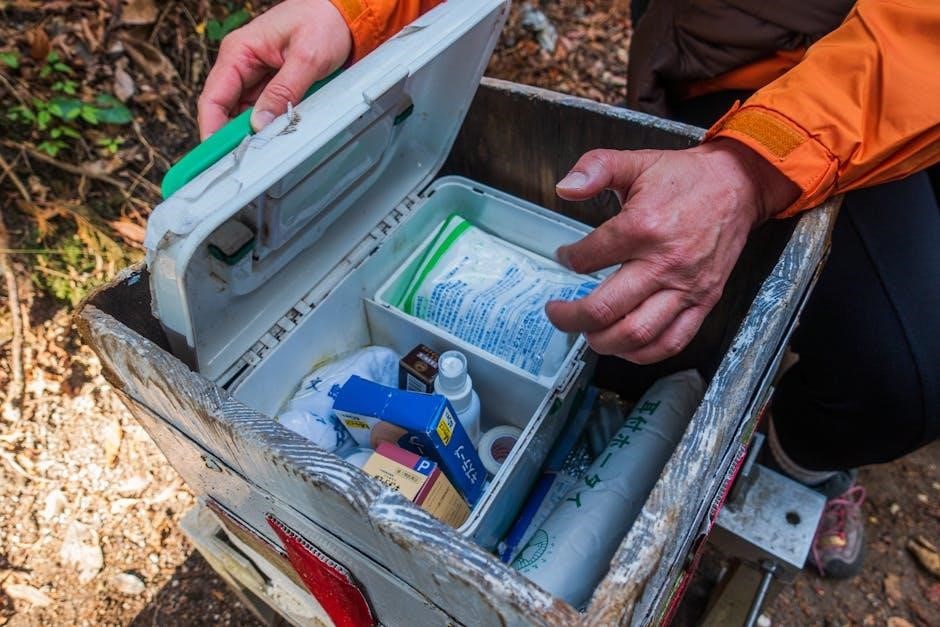
Importance of Having a First Aid Kit
Importance of Having a First Aid Kit
A first aid kit is essential for responding to medical emergencies, enabling immediate care that can prevent minor injuries from escalating․ It equips individuals with necessary supplies like bandages, antiseptics, and gloves, ensuring prompt treatment․ Having a well-stocked kit at home, in the car, or at work fosters preparedness for accidents, reducing recovery time and the risk of complications․ It also provides peace of mind, knowing you can address sudden illnesses or injuries effectively․ Regularly checking and restocking the kit ensures all items are usable and not expired․ A first aid kit checklist, often available as a printable PDF, helps maintain organization and compliance with safety standards․ This preparedness is crucial for protecting health and safety in various settings, from workplaces to outdoor adventures, emphasizing the importance of being ready to act swiftly in emergencies․

Purpose of a First Aid Kit Checklist
A first aid kit checklist serves as a comprehensive guide to ensure all essential supplies are present and easily accessible․ Its primary purpose is to help individuals and organizations maintain a well-stocked first aid kit, tailored to specific needs such as workplace, travel, or outdoor activities․ By following a checklist, one can verify the presence of critical items like bandages, antiseptics, gloves, and medications, ensuring nothing is overlooked․ It also helps track expiration dates and quantities, preventing shortages during emergencies․ Printable PDF checklists, widely available online, offer a convenient way to stay organized․ Regular use of a checklist promotes preparedness, reducing response time and improving outcomes in medical emergencies․ This tool is indispensable for households, businesses, and adventurers, ensuring they are equipped to handle unexpected situations effectively․ Ultimately, a first aid kit checklist acts as a safeguard, guaranteeing readiness for various scenarios and promoting overall safety․
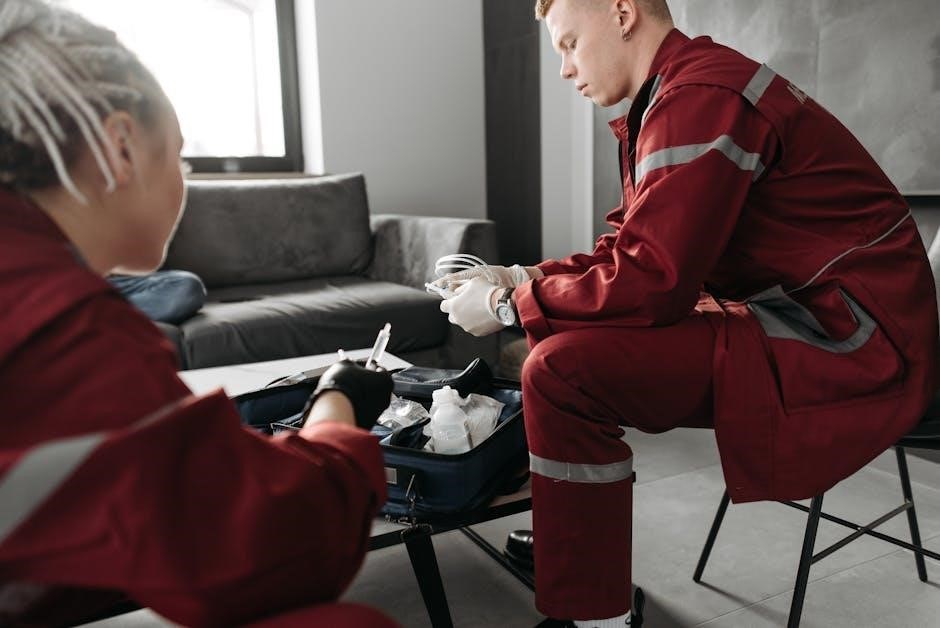
Essential Items for a First Aid Kit
A well-prepared first aid kit includes bandages, antiseptic wipes, gloves, scissors, and medications․ These items address wounds, injuries, and minor illnesses, ensuring timely and effective care during emergencies․
Wound Care and Bandages
Wound Care and Bandages
Wound care and bandages are critical components of a first aid kit, ensuring proper treatment of injuries․ Essential items include sterile dressings, gauze pads, adhesive bandages in assorted sizes, rolled gauze, and medical tape․ Scissors are also necessary for cutting bandages to fit wounds․ These supplies help prevent infection, promote healing, and provide protection for cuts, scrapes, and burns․ Adhesive bandages are ideal for minor injuries, while gauze pads and rolls are suitable for larger or deeper wounds․ Sterile dressings are vital for maintaining a clean environment to reduce the risk of infection․ Regularly checking these items ensures they are not expired or depleted, allowing for immediate and effective wound management in emergencies․ Proper organization of these supplies in the kit makes them easily accessible during critical moments, ensuring timely care for injuries of varying severity․
General Medical Supplies
General Medical Supplies
General medical supplies are fundamental to any first aid kit, providing essential tools for treating a variety of conditions․ These include antiseptic wipes, disposable gloves, and over-the-counter medications like pain relievers, antihistamines, and antidiarrheal agents․ Thermometers, both digital and oral, are crucial for assessing fevers․ Other key items are eye wash solutions, hydrocortisone cream for allergic reactions, and cold packs to reduce swelling․ Medical tape and scissors are also necessary for securing dressings and cutting bandages․ These supplies ensure that common ailments and minor injuries can be managed effectively․ Regularly checking expiration dates and replenishing stocks is vital to maintain their effectiveness; Always store these items in an easily accessible and organized manner to facilitate quick response during emergencies․ Including these supplies in your first aid kit ensures comprehensive preparedness for various medical situations, from minor scrapes to more serious conditions requiring immediate attention․
Personal Protective Equipment
Personal Protective Equipment
Personal Protective Equipment (PPE) is a critical component of any first aid kit, designed to protect both the caregiver and the injured individual from potential biohazards․ Essential PPE items include disposable gloves, which prevent direct contact with bodily fluids, and face masks, which reduce the risk of airborne pathogen transmission․ Eye protection, such as goggles, is also important to safeguard against splashes or spills․ Hand sanitizer or antibacterial wipes should be included to maintain hand hygiene when soap and water are unavailable․ These items are vital for ensuring safety during emergency situations and are often required by workplace and health regulations․ Regularly inspecting PPE for damage or expiration is crucial to guarantee its effectiveness․ Including PPE in your first aid kit checklist helps maintain preparedness and adherence to safety standards, minimizing risks during medical interventions․ Always prioritize quality and compliance with recommended guidelines when selecting these supplies․
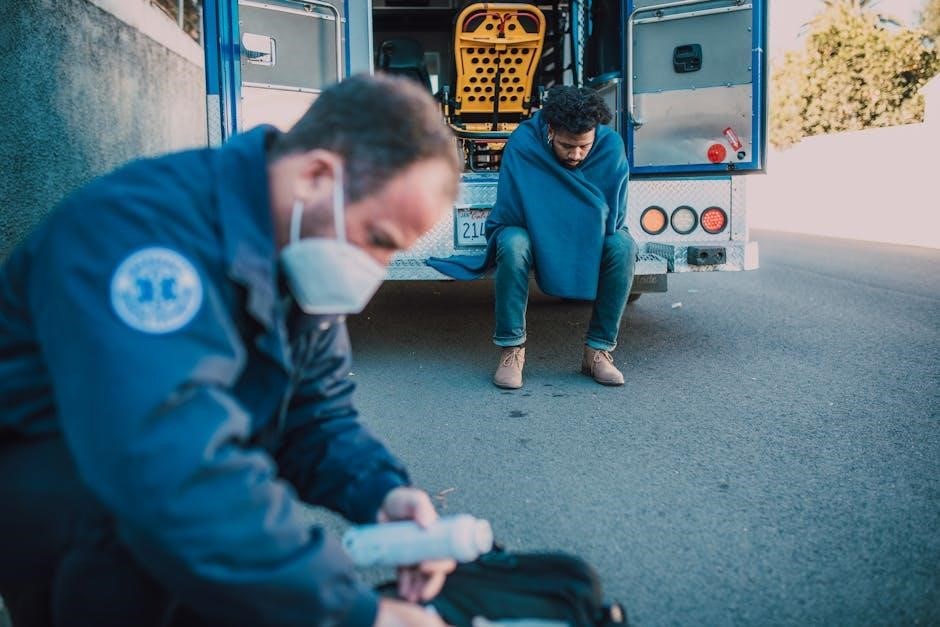
Specialized First Aid Kits
Specialized first aid kits cater to specific environments and needs, such as workplaces, travel, and outdoor activities, ensuring tailored supplies for unique situations and compliance with industry standards․
Workplace First Aid Kits
Workplace first aid kits are essential for ensuring employee safety and compliance with regulations like OSHA and ANSI standards․ These kits typically include items such as bandages, antiseptics, gloves, and wound care supplies․ Employers must regularly inspect and restock kits to maintain readiness․ Specific industries may require additional items based on workplace hazards․ Digital checklists, including printable PDF templates, help employers track supplies and ensure compliance․ Regular updates and employee training on kit usage are crucial for effective emergency response․ A well-maintained workplace first aid kit not only prevents minor injuries from escalating but also demonstrates a commitment to worker well-being and safety standards․
Travel First Aid Kits
A well-prepared travel first aid kit is vital for managing minor injuries and preventing larger issues while away from home․ It should include essentials like band-aids, antiseptic wipes, pain relievers, and gloves․ Compact and portable, these kits are designed to fit easily in luggage․ Consider adding items specific to your destination, such as insect repellent or altitude sickness medication․ Check expiration dates and replenish supplies before each trip․ A travel first aid kit checklist, available as a printable PDF, helps ensure nothing is forgotten․ According to experts, including the CDC, travelers should tailor their kits based on the length and type of trip․ Packing a small first aid manual or guide can also provide useful guidance in emergencies; Regularly reviewing and updating your travel first aid kit ensures it remains ready for any situation, helping you stay safe and healthy on the go․
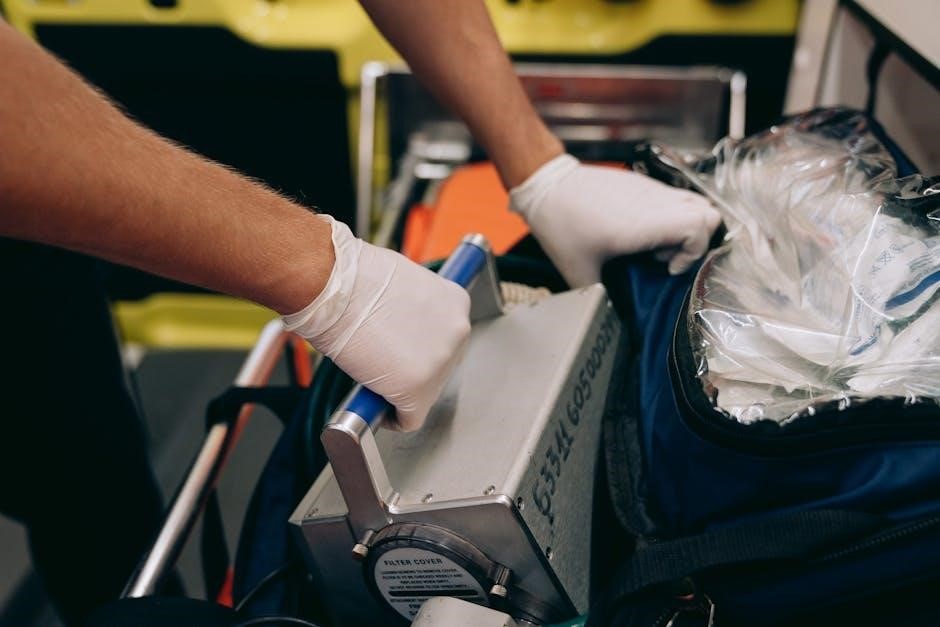
Outdoor and Hiking First Aid Kits
An outdoor and hiking first aid kit is tailored for adventures in remote areas, where medical help may be inaccessible․ It should include essentials like bandages, antiseptic wipes, pain relievers, and blister care․ A wilderness first aid kit often contains items specific to outdoor injuries, such as snake bite kits, burn dressings, and fracture splints․ Multi-use tools like duct tape, a multi-tool, or a knife can also be invaluable․ Consider the duration and location of your trip when packing, as longer hikes or extreme weather may require additional supplies like emergency blankets or altitude sickness remedies․ A printable PDF checklist can help ensure all items are included and organized․ Regularly inspecting and updating your kit is crucial, as outdoor environments can be harsh on supplies․ Tailoring your kit to the unique risks of your adventure ensures you’re prepared for unexpected situations, helping you stay safe in the wilderness․
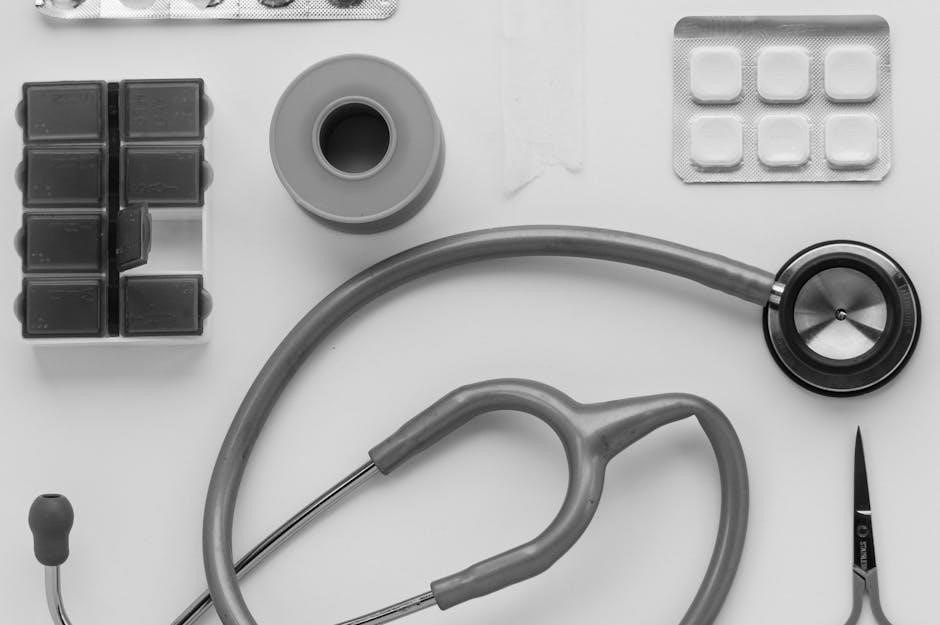
Maintenance and Replenishment of First Aid Kits
Regular checks ensure first aid kits remain stocked and ready․ Restock used or expired items promptly, using a checklist to verify completeness․ This routine maintains preparedness and ensures safety in emergencies․
Regular Checks and Updates
Regular Checks and Updates
Regular checks are crucial to ensure a first aid kit remains fully functional․ Schedule monthly inspections to verify all items are present, not expired, and usable․ This proactive approach prevents shortages during emergencies․ Use a PDF checklist to systematically review each item, from bandages to medications․ After each check, restock or replace items as needed․ Additionally, stay informed about updates to first aid guidelines and standards, as they may require adding new supplies․ Keeping a checklist inside the kit helps maintain accountability and serves as a quick reference during inspections․ Consistent updates ensure the kit adapts to changing needs, whether at home, work, or while traveling․ Regular maintenance is the cornerstone of a reliable first aid kit, ensuring it’s always ready to provide effective care when needed․
Replenishing Supplies
Replenishing Supplies
Replenishing supplies is essential to maintain the effectiveness of a first aid kit․ After identifying shortages or expired items during regular checks, restock promptly to ensure readiness for emergencies․ Use a first aid kit checklist PDF to track which items need replacement․ Pay attention to expiration dates, especially for medications like antihistamines, antiseptics, and hydrocortisone․ Soiled or damaged items, such as bandages or gloves, should also be replaced․ Keep a list of reliable suppliers or pharmacies for quick restocking․ Organizing the kit after replenishment ensures items are easy to find during an emergency; Consider adding a note or digital reminder to schedule future checks․ Regular replenishment prevents gaps in care and ensures the kit remains a reliable resource for unexpected situations․ By staying proactive, you can maintain a well-stocked first aid kit tailored to your specific needs․ This practice is vital for both home and workplace settings․ Consistent replenishment is key to saving lives and preventing minor injuries from escalating․
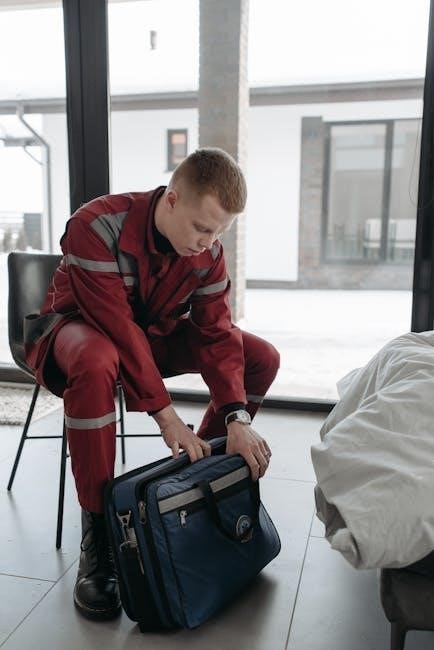
Regulations and Standards for First Aid Kits
Regulations ensure first aid kits meet safety and legal standards․ OSHA and ANSI guidelines outline required supplies like bandages, gloves, and antiseptics, ensuring preparedness for emergencies and compliance with workplace safety laws․

OSHA Regulations
OSHA Regulations
OSHA regulations mandate employers to provide accessible first aid kits meeting specific standards․ Kits must include supplies like bandages, antiseptics, gloves, and eye wash solutions․ Employers must train staff in kit use and maintenance, ensuring compliance with workplace safety laws․ Regular inspections and replenishment of items are required to maintain preparedness․ Adherence to these guidelines helps prevent injuries and ensures prompt treatment, aligning with OSHA’s goal of workplace safety․ Employers failing to comply may face penalties, emphasizing the importance of strict compliance with OSHA’s first aid kit standards․ Kits must be suitably marked and easily accessible, reflecting OSHA’s commitment to employee well-being and emergency preparedness․
ANSI Standards
ANSI standards provide detailed guidelines for first aid kits, ensuring they meet minimum requirements for workplace safety․ These standards specify the types and quantities of supplies, such as adhesive bandages, antiseptic wipes, gloves, and eye wash solutions․ Kits are categorized based on workplace size and hazard levels, with recommendations for restocking and maintenance․ ANSI standards emphasize the importance of accessibility and visibility of first aid kits, ensuring they are readily available in emergencies․ Employers must adhere to these guidelines to ensure compliance with safety regulations and to protect employees from preventable injuries․ Regular audits and updates are encouraged to maintain kit effectiveness․ By following ANSI standards, organizations can create a safer work environment and reduce the risk of accidents․ These standards serve as a comprehensive framework for designing and maintaining reliable first aid kits tailored to specific workplace needs․
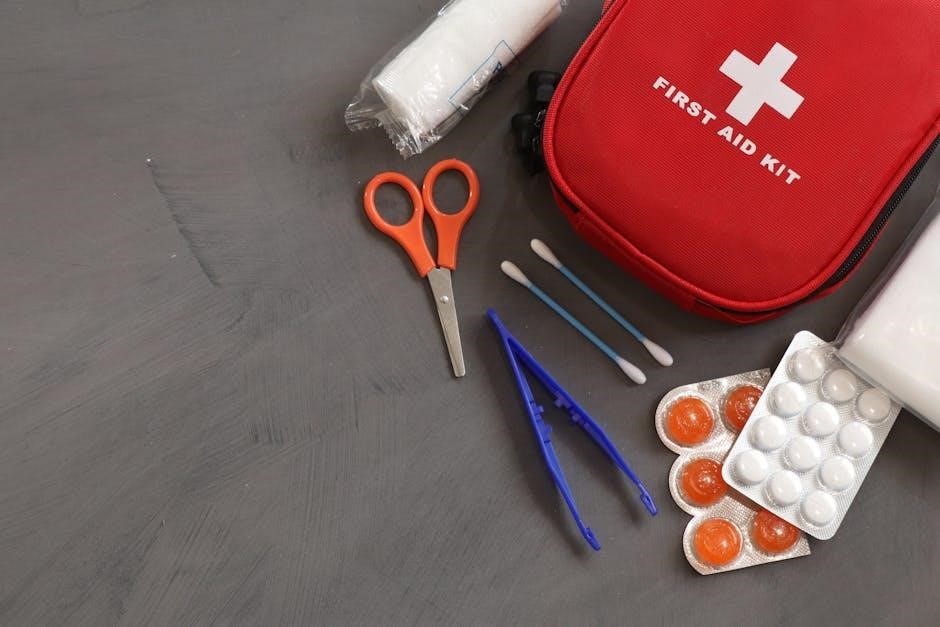
Digital Resources for First Aid Kit Checklists
Free printable PDF checklists are available online, offering comprehensive guides for first aid supplies․ These resources ensure kits are well-stocked and meet safety standards, making emergency preparedness easier and more accessible for everyone․
Printable PDF Checklists
Printable PDF Checklists
Printable PDF checklists for first aid kits provide a structured and efficient way to ensure all essential supplies are included․ These templates typically categorize items, such as wound care, bandages, antiseptics, gloves, and medical tools like scissors and tweezers․ Many checklists also include sections for pain relievers, cold packs, and burn gel, along with reminders to check expiration dates of medications․ Some advanced kits may incorporate optional items like EpiPens or AEDs for severe emergencies․ Organized by categories, these checklists often feature boxes or checkmarks for easy verification․ Regular updates and reviews, typically every few months, are recommended to maintain kit readiness․ Additionally, including emergency contact information and adherence to guidelines like OSHA standards can enhance the checklist’s utility, particularly in workplace settings․ Overall, these PDF checklists serve as a comprehensive yet straightforward guide to assembling and maintaining an effective first aid kit․
Online Templates and Guides
Online Templates and Guides
Online templates and guides provide convenient access to creating or updating a first aid kit checklist․ Websites like the Red Cross and CDC offer downloadable resources tailored for home, travel, or workplace use․ These guides often include customizable templates to suit specific needs, such as outdoor adventures or vehicle kits․ Many online tools allow users to track expiration dates of medications and set reminders for restocking supplies․ Interactive checklists enable real-time updates, ensuring the kit remains relevant and fully stocked․ Step-by-step guides also offer tips on organizing the kit and prioritizing essential items․ Some platforms even provide video tutorials for assembling kits or using the supplies effectively․ By leveraging these digital tools, users can ensure their first aid kits are always prepared for emergencies, whether at home, in the workplace, or on the go․ These resources make maintaining a well-stocked first aid kit straightforward and efficient․
A well-stocked first aid kit is essential for addressing emergencies effectively․ By using a first aid kit checklist PDF, individuals and organizations can ensure preparedness and compliance with safety standards․ Regular checks and updates guarantee that supplies remain relevant and usable․ Printable templates and online guides simplify the process of maintaining a first aid kit, offering customizable solutions for various settings, from homes to workplaces․ These resources emphasize the importance of organization, expiration tracking, and restocking, ensuring kits are always ready for unexpected situations․ Whether for minor injuries or critical incidents, a properly maintained first aid kit can make a significant difference in outcomes․ Remember, preparedness is key to saving lives and preventing further harm in emergencies․